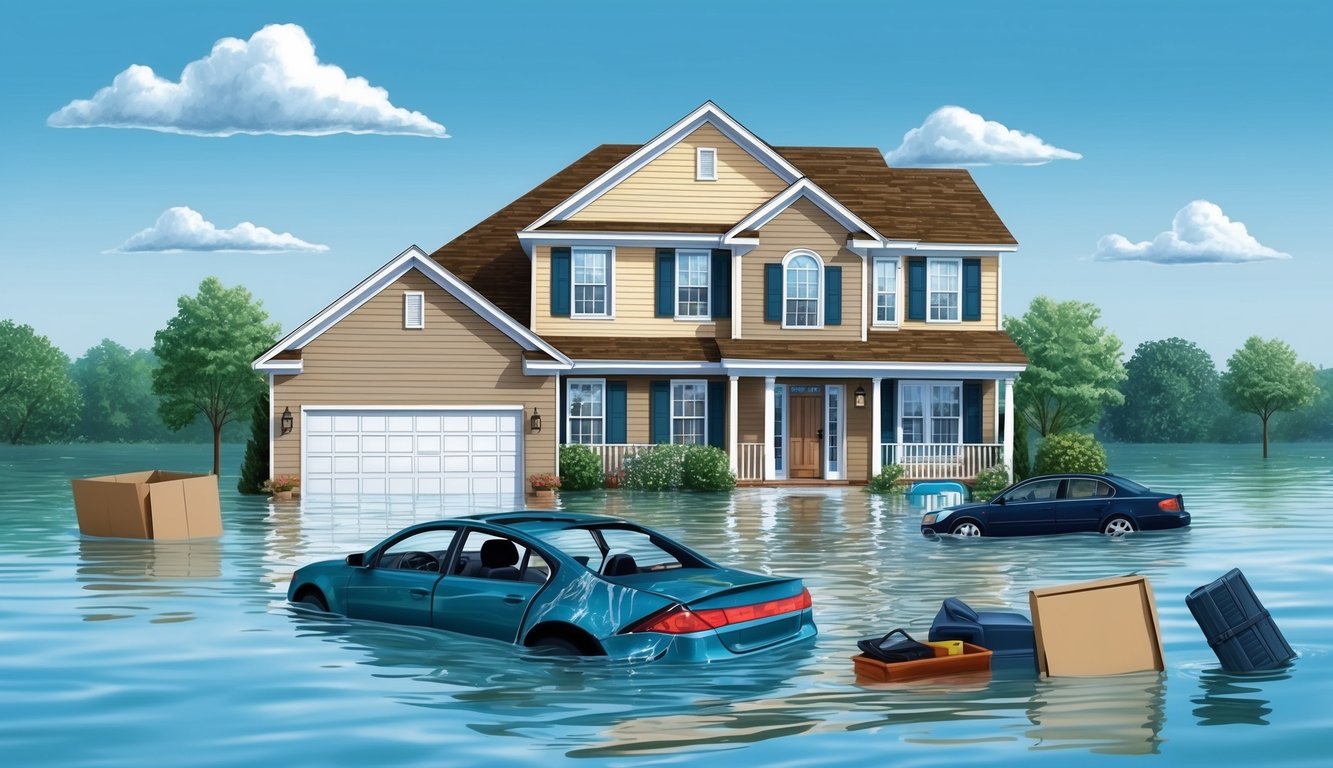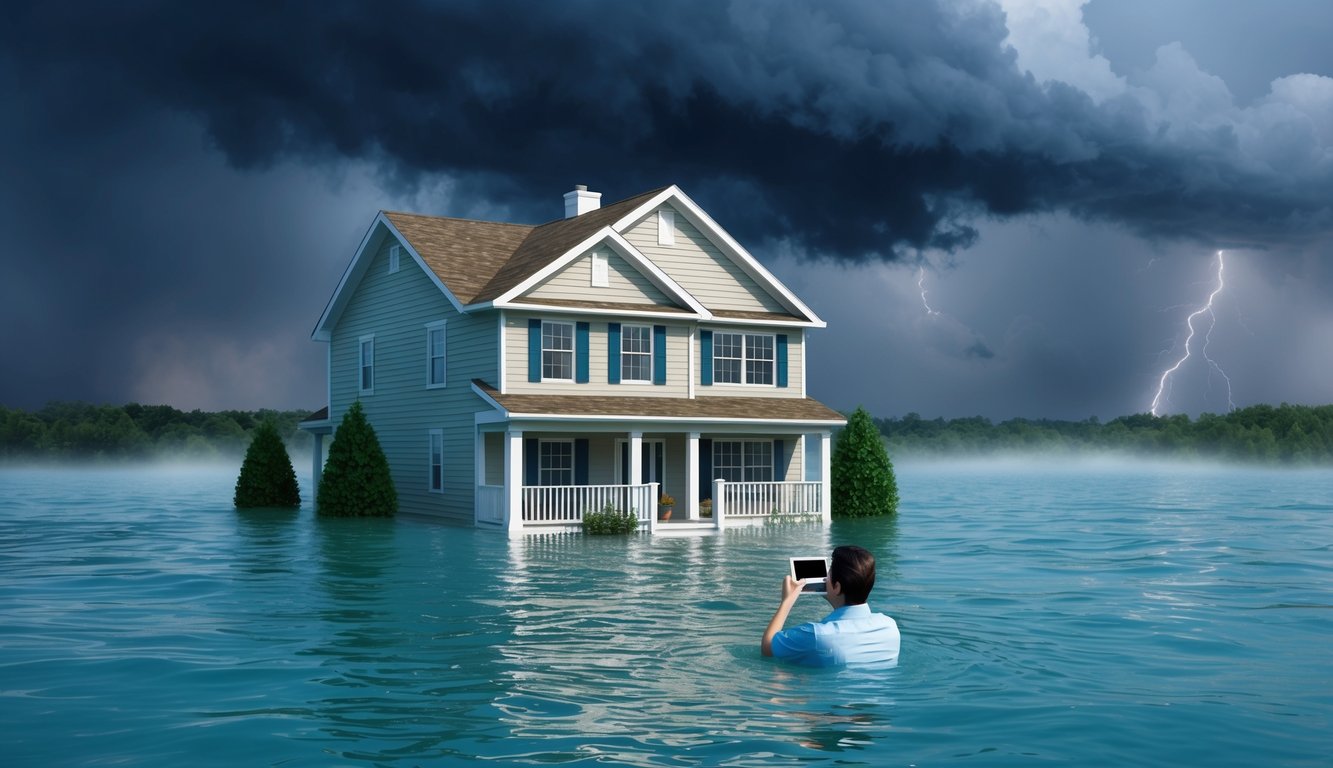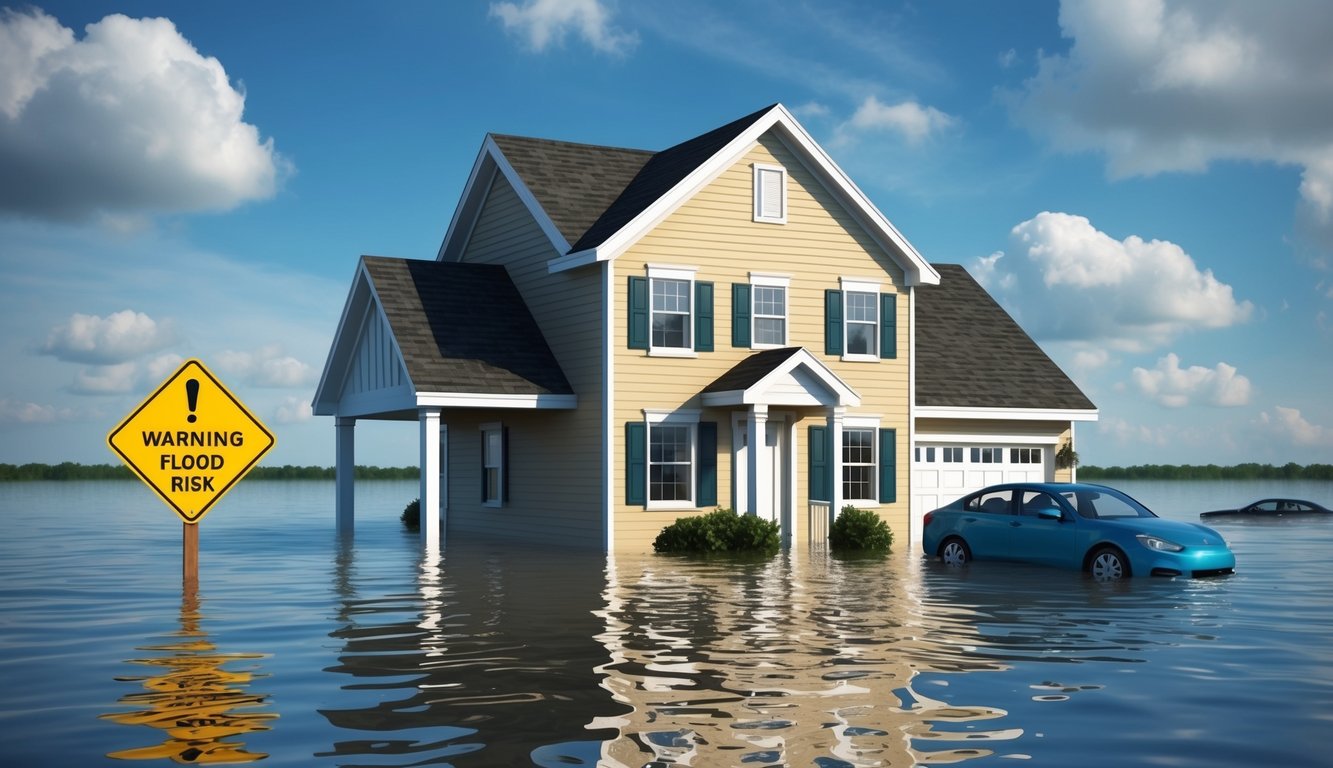Flood insurance is a crucial safeguard for protecting your property and belongings from water-related disasters.
As natural events become more unpredictable, having the right coverage can make all the difference in your financial recovery after a flood.
Avoiding common mistakes when purchasing flood insurance can save you money and ensure adequate protection for your home. By understanding the key factors to consider and potential pitfalls to sidestep, you can make an informed decision that aligns with your specific needs and circumstances.
1) Ignoring Exclusions
When purchasing flood insurance, you need to pay close attention to policy exclusions.
These are specific situations or types of damage that your policy won’t cover.
Many homeowners make the mistake of assuming their flood insurance covers all water-related damage.
This assumption can lead to costly surprises when filing a claim.
Standard flood insurance policies often exclude damage caused by moisture, mildew, or mold that could have been prevented by the property owner.
It’s essential to understand these limitations to protect your home effectively.
Another common exclusion is damage to outdoor property.
Items like fences, swimming pools, and landscaping may not be covered by your flood insurance policy.
You should also be aware that flood insurance typically doesn’t cover living expenses if you need to temporarily relocate due to flood damage.
This is an important consideration when planning for potential disasters.
To avoid these pitfalls, carefully review your policy’s exclusions with your insurance agent.
Ask questions about any terms or situations you don’t fully understand.
Consider purchasing additional coverage or separate policies to address gaps in your flood insurance.
This proactive approach can save you from financial hardship in the event of a flood.
2) Neglecting Contents Coverage
When purchasing flood insurance, you might focus solely on protecting your home’s structure.
This oversight can leave your personal belongings vulnerable to flood damage.
Contents coverage is a crucial component of flood insurance.
It protects your furniture, clothing, electronics, and other personal items from flood-related losses.
Many homeowners underestimate the value of their possessions.
Take time to inventory your belongings and assess their worth.
This will help you determine the appropriate amount of contents coverage.
Standard flood insurance policies often have limited contents coverage.
The National Flood Insurance Program (NFIP) caps contents coverage at $100,000.
If your belongings exceed this value, consider additional private flood insurance.
Some private insurers offer contents coverage up to $500,000.
Be aware that certain items may have specific coverage limits.
Valuable artwork, jewelry, or collectibles might require separate policies or riders.
Remember that flood damage to personal property in basements is often excluded or limited.
Review your policy carefully to understand these restrictions.
By prioritizing contents coverage, you ensure comprehensive protection for both your home and your possessions.
This approach can significantly reduce your financial burden in the event of a flood.
3) Underestimating Risk
Many homeowners make the mistake of underestimating their flood risk.
You might think your property is safe because it’s not in a designated high-risk flood zone.
However, flood risk is not the same as flood zone designation.
Flood zones can change over time due to factors like urbanization and climate change.
Your area might be at risk even if it hasn’t flooded in recent memory.
Don’t assume you’re safe just because you live in a low-risk area. Approximately 25% of flood insurance claims come from low to moderate-risk zones.
It’s crucial to assess your true flood risk accurately.
Consider factors like your property’s elevation, proximity to water bodies, and local drainage systems.
Remember that even a few inches of water can cause significant damage to your home and belongings.
Flood damage is often more extensive and costly than people anticipate.
Take the time to research historical flood data for your area.
Consult with local flood experts or insurance specialists to get a clearer picture of your risk.
By understanding your true flood risk, you can make informed decisions about insurance coverage.
This knowledge helps ensure you’re adequately protected against potential flood damage.
4) Failing to Compare Policies
When purchasing flood insurance, it’s crucial to compare different policies.
Many homeowners make the mistake of accepting the first policy they encounter without exploring other options.
Shopping around for flood insurance can help you find better coverage at more competitive rates.
Each insurance provider may offer different terms, coverage limits, and pricing structures.
Take the time to research multiple insurance companies and their offerings.
You can request quotes from various providers to compare costs and coverage options side by side.
Pay attention to the specific details of each policy.
Look at factors such as deductibles, coverage limits, and any exclusions or additional riders that may be available.
Consider consulting with a flood insurance specialist who can guide you through the comparison process.
They can help you understand the nuances of different policies and identify the one that best suits your needs.
Remember that the cheapest option isn’t always the best.
Focus on finding a policy that provides adequate coverage for your specific situation and property.
By comparing policies, you can make an informed decision and potentially save money while ensuring you have the right level of protection for your home.
5) Overlooking Deductibles

When purchasing flood insurance, paying attention to deductible amounts is crucial.
Your deductible is the amount you’ll pay out of pocket before your insurance coverage kicks in.
Many policyholders make the mistake of overlooking deductible amounts when buying insurance.
This oversight can significantly impact your financial situation if you need to file a claim.
Lower deductibles typically mean higher premiums, while higher deductibles result in lower premiums.
It’s essential to strike a balance that fits your budget and risk tolerance.
Consider your financial situation carefully when choosing a deductible.
Can you comfortably afford to pay the deductible amount if you need to file a claim?
Be aware that flood insurance often has separate deductibles for building coverage and contents coverage.
Make sure you understand both and how they might affect you in the event of a flood.
Remember that deductibles differ from out-of-pocket maximums.
Your deductible is what you pay before insurance starts covering costs, while an out-of-pocket maximum is the total amount you’re responsible for in a given period.
By carefully considering your deductible options, you can ensure you’re not caught off guard if you need to file a claim.
Take the time to review and understand this aspect of your flood insurance policy.
Understanding Flood Insurance Basics

Flood insurance protects your property from water damage caused by flooding events.
It’s essential to know what your policy covers and the different types available to make an informed decision.
What Flood Insurance Covers
Flood insurance policies typically cover direct physical damage to your insured property.
This includes damage to the building’s structure and its contents, up to specified limits.
For residential properties, coverage usually extends to:
- Foundation walls and staircases
- Electrical and plumbing systems
- Central air conditioning equipment
- Furnaces and water heaters
- Refrigerators, cooking stoves, and built-in appliances
Personal property coverage may include:
- Clothing and furniture
- Washers and dryers
- Portable microwave ovens and dishwashers
- Valuables up to a certain limit
It’s important to note that basement areas have limited coverage.
Some items, like artwork or important documents, may require additional coverage.
Types of Flood Insurance Policies
There are two main types of flood insurance policies available:
-
National Flood Insurance Program (NFIP) policies:
- Offered by the federal government
- Cover up to $250,000 for home structure
- Provide up to $100,000 for contents
-
Private flood insurance policies:
- Offered by private insurance companies
- May provide higher coverage limits
- Can offer more flexible terms and conditions
For high-value homes, you might need to consider excess flood insurance to supplement your NFIP policy.
This additional coverage can protect you if your property’s value exceeds the NFIP limits.
Private policies may offer more comprehensive coverage, including living expenses if you’re displaced due to flooding.
They might also have shorter waiting periods before the policy takes effect compared to NFIP policies.
Evaluating Your Flood Risk

Accurately assessing your property’s flood risk is crucial for making informed decisions about flood insurance.
Understanding your flood zone designation and considering the impacts of climate change will help you determine appropriate coverage levels.
Flood Zone Determination
Flood zone designations are important, but they don’t tell the whole story.
FEMA flood maps categorize areas based on risk levels, from high-risk zones (A and V) to moderate-to-low risk zones (B, C, and X).
To find your property’s flood zone:
- Visit FEMA’s Flood Map Service Center
- Enter your address
- Review the mapped flood zones
Remember, these maps may not reflect recent changes or local flooding patterns.
Consider hiring a surveyor for a more accurate assessment, especially if you’re near zone boundaries.
Don’t assume low-risk zones are safe.
About 25% of flood claims come from properties outside high-risk areas. Evaluate your specific location, considering factors like:
- Proximity to water bodies
- Local topography
- Historical flood data
Impact of Climate Change
Climate change is altering flood risks across the country.
More frequent and severe flooding events are caused by rising sea levels, increased rainfall intensity, and changing weather patterns.
When evaluating your flood risk:
- Research projected climate impacts for your area.
- Consider long-term trends in local flooding.
Look beyond current flood maps, which may not account for future risks.
Use tools like NOAA’s Sea Level Rise Viewer or Climate Central’s Surging Seas to visualize potential impacts.
These resources can help you understand how your flood risk might change over time.
Flood insurance decisions should account for both current and future risks.
As climate patterns shift, areas previously considered low-risk may face increased flooding potential.
Choosing the Right Coverage

Selecting appropriate flood insurance coverage is crucial to protect your property adequately.
Proper coverage ensures you’re not underinsured in the event of a flood, helping you avoid financial hardship.
Assessing Your Property’s Value
To choose the right coverage, start by accurately assessing your property’s value.
Include the cost to rebuild your home and replace personal belongings.
Don’t forget to factor in potential inflation and rising construction costs.
Consider hiring a professional appraiser to get an accurate estimate.
This helps ensure you’re not underinsured if a flood occurs.
Remember to reassess your property’s value periodically, especially after renovations or major improvements.
Your coverage should reflect these changes to maintain adequate protection.
Understanding Policy Limits
Familiarize yourself with the limits of your flood insurance policy.
The National Flood Insurance Program (NFIP) has a maximum coverage of $250,000 for building property and $100,000 for contents.
If your property value exceeds these limits, you should consider purchasing excess flood insurance from private insurers.
This additional coverage can help bridge the gap between NFIP limits and your actual property value.
Be aware of what your policy does and doesn’t cover.
For example, many policies don’t cover damage from mold or mildew that could have been prevented.
Review your policy annually to ensure it still meets your needs.
This is important as your property value and circumstances change.






